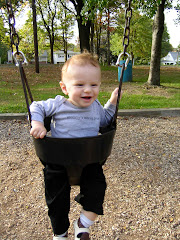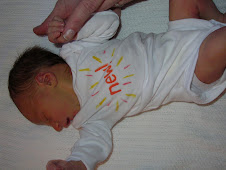This afternoon's nap lasted at least two hours! I periodically checked in, to see if he was A) still asleep, and B) still breathing. At one point he cried, but then settled himself down. When I next checked on him, I found this scene:

He was fast asleep...on his belly! He slept like this for a while. Of course, my check-ins became much more frequent as all of the SIDS-prevention "Back to Sleep" propaganda has worked its magic on me (I know, how did we ever survive?), and I was freaking out about him being face down.
Granted, I realize we could play a great round of "Can you name all the dangers in this napping photograph?"
So, can you?
Blanket, belly, bear...
Meanwhile, I got lots of cleaning done! I think he would've slept even longer had he not been awakened by the dreaded vacuum. . .














































2 comments:
James is soo cute snuggling with a teddy bear. I love all the new skillz!
(evidently being signed into gmail means i can post comments - woot.)
I'm surfing the blogs for info on SIDS. I'm a medical writer and I think it's an interesting subject and that many of the "cures" might actually not be that safe and that the statistics are highly inflated:
In a 2006 letter to the editor in the Journal of Pediatrics Dr. Rafael Pelayo, Dr. Judith Owens, Dr. Jodi Mindell, and Dr. Stephen Sheldon asked the following question of the American Academy of Pediatrics Task Force on Sudden Infant Death Syndrome after their Pacifier and Co-sleeping report was published:
"...from the perspective of the field of pediatric sleep medicine, the policy statement's laudable but narrow focus on SIDS prevention raises a number of important issues that need to be addressed. In particular, the revised recommendations regarding cosleeping and pacifier use have the potential to lead to unintended consequences on both the sleep and the health of the infant. The potential implications of a SIDS risk-reduction strategy that is based on a combination of maintaining a low arousal threshold and reducing quiet (equivalent to Delta or slow-wave sleep) in infants must be considered. Because slow-wave sleep is considered the most restorative form of sleep and is believed to have a significant role in neurocognitive processes and learning, as well as in growth, what might be the neurodevelopmental consequences of chronically reducing deep sleep in the first critical 12 months of life?"
"There are indications of a rapidly growing population of infants who show developmental abnormalities as a result of prolonged exposure to the supine position."
Dr. Ralph Pelligra regarding the impact of the Back to Sleep Campaign
http://www.websciences.org/cftemplate/NAPS/archives/indiv.cfm?ID=20046610
"In its fundamental purpose it has been largely successful. The incidence of SIDS has been reduced dramatically. However, as many orthotists can attest, this important gain has not been without its lesser comorbidities. The one we tend to think of has been the rapid increase in the incidence of positional plagiocephaly and positional brachycephaly. However, there have been whispers and rumors of other effects."
Phil Stevens, MEd, CPO regarding side effects of the Back to Sleep Campaign.
http://www.oandp.com/edge/issues/articles/2006-12_02.asp
"Since the implementation of the "Back to Sleep" campaign, therapists are seeing increasing numbers of kindergarten-aged children who are unable to hold a pencil."
Susan Syron, Pediatric Physical Therapist
"A lot of us are concerned that the rate (of SIDS) isn't decreasing significantly, but that a lot of it is just code shifting,' said John Kattwinkel, chairman of the Centers for Disease Control and Prevention's special task force on SIDS. 'We don't know where the best place is to put our emphasis on further reducing the risk of SIDS. It is still a very high killer of babies.'"
http://www.shns.com/shns/g_index2.cfm?action=detail&pk=SIDS-10-08-07
Post a Comment